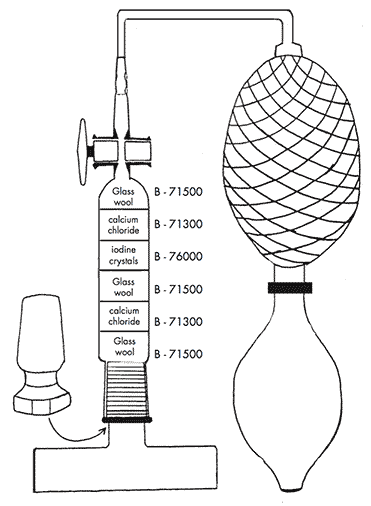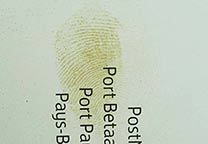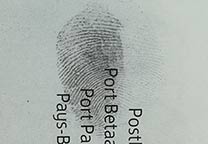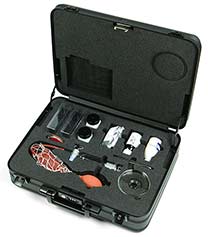General
Latent fingerprints of some days - sometimes weeks -
old, can be developed (among other methods) by the BVDA Iodine Fuming
Kit. This process is known as the iodine fuming method.
The iodine
fuming method may be used on most porous (like paper, cardboard, and
unpainted wood) and non-porous surfaces (like hard plastics, porcelain).
The
iodine vapour is physically adsorbed by latent fingerprint deposits to
give a brown image. There is also some reaction with unsaturated fats,
present in those deposits. Because of the corrosivity of iodine, the
method is less suitable for non-painted metals, such as aluminium. Due
to the brown image that fingerprints develop upon iodine vapour
treatment, the method is also not suitable for use on dark surfaces.
Since
the iodine adsorbed by objects slowly (measured in minutes) vapourizes
again after removing the fumer, prints should be photographed as soon as
possible, or fixed. Because of the vaporization of the iodine, the
iodine fuming method can be used on objects before other methods (e.g.
ninhydrin or indanedione treatment of paper) are tried, without any
interference (assuming no fixing is done). The method may, however,
interfere with the forensic examination of body fluids.
WARNING: Iodine vapour is toxic and very corrosive. Therefore, care should be taken to minimize inhalation of the vapour.
Instructions for use
The
BVDA Iodine Fuming Set consists of the Iodine fumer (B-72000), which
should be filled with the chemicals from the set (B-71000), in
accordance with the drawing.

The glass wool serves to hold the chemicals in the tube in place. It should therefore be put on both ends.
When the fumer is not in use, the tap should be closed and the dish at the other end replaced by the tight fitting stopper.
On
using the iodine fumer, the assembly as shown on the drawing is used.
Close the tap first, before inflating the second rubber balloon (with
net), with the first balloon. Put the Iodine fumer ON the object (e.g. a
piece of paper) and open the tap. The amount of iodine fume can be
controlled by obstructing the air stream from the second balloon with
the tap.
Do not put the Iodine fumer OVER the object, because in
this way the iodine vapour will disappear quickly without aiding
development.
When using the iodine fumer, the tube can be held
at the height of the iodine crystals. The heat of the hand thus provided
will accelerate the vaporization of the iodine.
Benzoflavone iodine fix
As
described above, prints developed with iodine will fade, due to the
revaporization of the iodine. The prints can be fixed, however, with
benzoflavone iodine fix B-74500. The fixing solution can be applied by
coating the developed print by a brush or cotton wool, which has been
wetted with the fluid. To obtain an equal distribution of the fixing
solution, it is strongly recommended to use a sprayer, however (for
example a laboratory TLC sprayer).
After treatment with benzoflavone iodine-fix B-74500, the brown colour of the print will have changed to blue/dark blue.
Fingerprints
fixed with benzoflavone will be permanent. On non-porous surfaces the
prints can be removed by wiping with alcohol.
Silver lifting plate
It is also possible to lift latent prints, developed by the iodine fuming method, with the Silver lifting plate B-73000.
For
this purpose, the silver plate should be put on the brown coloured
fingerprint and left there for 2 - 3 minutes. The iodine fume will
attack the silver plate and the fingerprint will show up (in reverse) as
a dark brown or black print. The development is accelerated by sun
light.
After photographing or examining the print, the silver plate can be cleaned with silver cleaner B-73100.











